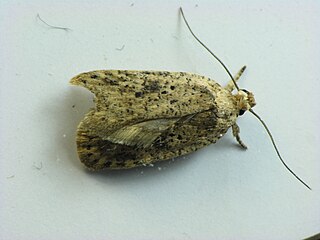| Exaeretia canella | |
|---|---|
| Scientific classification | |
| Kingdom: | |
| Phylum: | |
| Class: | |
| Order: | |
| Family: | |
| Genus: | |
| Species: | E. canella |
| Binomial name | |
| Exaeretia canella (Busck, 1904) | |
| Synonyms | |
| |
Exaeretia canella is a moth in the family Depressariidae. It was described by August Busck in 1904. [1] It is found in North America, where it has been recorded from California, Washington, from British Columbia to Quebec, Idaho, Colorado, Montana, Wyoming, Michigan, New Hampshire, New York and Connecticut. [2]

Moths comprise a group of insects related to butterflies, belonging to the order Lepidoptera. Most lepidopterans are moths, and there are thought to be approximately 160,000 species of moth, many of which have yet to be described. Most species of moth are nocturnal, but there are also crepuscular and diurnal species.

Depressariidae is a family of moths. It has formerly been treated as a subfamily of Gelechiidae, but is now recognised as a separate family, comprising about 2300 species worldwide.
August Busck was a Danish entomologist who became an American citizen. Busck was an employee of the Bureau of Entomology within USDA. He is best known for his work with microlepidoptera, of which he described over 600 species. His collections of Lepidoptera from North America and the Panama Canal Zone are held by the National Museum of Natural History in Washington, D.C.
The wingspan is 16–20 mm. The forewings are pure white, marked with black, brown and fuscous. There are some inconspicuous black and fuscous spots and fine strigulae in the basal third and a large fuscous blotch is found from the costa at the middle, extending to near the middle of the cell. It is edged above and below with brown and is preceded by a black crescentic dash. There is a series of black or fuscous spots around the termen. The hindwings are light fuscous. It can be confused with Agonopterix alstroemeriana. [3]

The wingspan of a bird or an airplane is the distance from one wingtip to the other wingtip. For example, the Boeing 777-200 has a wingspan of 60.93 metres, and a wandering albatross caught in 1965 had a wingspan of 3.63 metres, the official record for a living bird. The term wingspan, more technically extent, is also used for other winged animals such as pterosaurs, bats, insects, etc., and other fixed-wing aircraft such as ornithopters. In humans, the term wingspan also refers to the arm span, which is distance between the length from one end of an individual's arms to the other when raised parallel to the ground at shoulder height at a 90º angle. Former professional basketball player Manute Bol stands at 7 ft 7 in (2.31 m) and owns one of the largest wingspans at 8 ft 6 in (2.59 m).

The hemlock moth, also known as the defoliating hemlock moth or poison hemlock moth, is a nocturnal moth species of the family Depressariidae. Of Palaearctic origin, it was first found in North America in 1973 when it was accidentally introduced. The moth is now widespread throughout the northern half of the United States, southern Canada, northern Europe, and, more recently, New Zealand. The larval form grows to around 10 mm, while the adults wingspan is between 17 mm and 19 mm.
The larvae feed on Antennaria luzuloides and Gnaphalium species. [4] They feed within tubes, formed from tied terminal leaves. A single larvae may construct several tubes. Full-grown larvae reach a length of 11–12 mm. They have a light yellowish body and light brown head. Pupation takes place in debris at the base of the plant.

Antennaria luzuloides is a North American species of flowering plants in the daisy family known by the common name rush pussytoes. The species is native to western Canada and the western United States.

Gnaphalium is a genus of flowering plants in the sunflower family, commonly called cudweeds. They are widespread and common in temperate regions, although some are found on tropical mountains or in the subtropical regions of the world.
